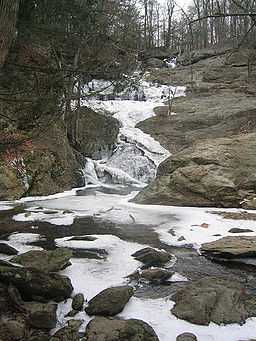Cunningham Falls State Park
| Cunningham Falls State Park | |
| Maryland State Park | |
 | |
| Country | United States |
|---|---|
| State | Maryland |
| County | Frederick |
| Elevation | 1,247 ft (380 m) [1] |
| Coordinates | 39°37′53″N 77°28′17″W / 39.63139°N 77.47139°WCoordinates: 39°37′53″N 77°28′17″W / 39.63139°N 77.47139°W [1] |
| Area | 5,942 acres (2,405 ha) [2] |
| - Wildlands | 3,452 acres (1,397 ha) [2] |
| Established | 1954 [3] |
| Management | Maryland Department of Natural Resources |
| style=""color: #cde5b2"" | IUCN category | V - Protected Landscape/Seascape |
|
Location in Maryland
| |
| Website: Cunningham Falls State Park | |
Cunningham Falls State Park is a state park located west of Thurmont, Maryland, USA, on Catoctin Mountain. It features a 43-acre (17 ha) man-made lake and its namesake waterfall, Cunningham Falls. Cunningham Falls is a 78-foot (24 m) cascade, the largest cascading waterfall in Maryland.[4] Catoctin Mountain Park borders the state park to the north. Catoctin Furnace, the remains of a historic iron furnace, can be toured in the park.
History
The Catoctin Mountain area around Cunningham Falls is rich in local history. Before the arrival of Europeans, Native Americans hunted and fished the area. The area was also quarried by Native Americans for rhyolite to make projectile points.[5] During the 19th century, settlers began to cut down the forests around the area to make charcoal to power the Catoctin iron furnace. The charcoal flats can still be seen in the park. The "charcoal flats" are approximately 25 by 25 feet (7.6 by 7.6 m) square areas cut flat into the hillsides and linked by mule trails. They were used to build charcoal kilns. Too many years of clear cutting and abuse of the forest led to the destruction of the land.[6]
In the 1930s, after years of making charcoal to fuel nearby iron furnaces, mountain farming, and harvesting of trees for timber, land was purchased by the Federal government to be transformed into a productive recreation area, helping to put people back to work during the Great Depression. Beginning in 1935, the Catoctin Recreational Demonstration Area was under construction by both the Works Progress Administration and the Civilian Conservation Corps. The northern portion of the park was transferred to the National Park Service on November 14, 1936, and renamed and reorganized on July 12, 1954, with the southern 5,000 acres (20 km2) transferred to Maryland as Cunningham Falls State Park.[7]
Known locally as McAfee Falls after a family of early settlers,[8] Cunningham Falls was apparently named after a photographer from Pen Mar Park who frequently photographed the falls.[6]
An old homestead can be seen above the falls. There is an abandoned gold or possibly copper mine located in the park.
West of the Falls on Big Hunting Creek lies "Dunkards Trough, a natural rock formation in the stream that forms a deep trough used by an early religious group (the Dunkards) for baptisms.
Activities and amenities
Common recreational activities include hiking, hunting, swimming, boating, fishing, and camping. Big Hunting Creek, one of Maryland's premier trout streams, flows through the park.[9]
Further reading
- Means, John. Maryland's Catoctin Mountain Parks, An Interpretive Guide to Catoctin Mountain Park and Cunningham Falls State Park. Blacksburg, VA 1995 ISBN 0-939923-38-6.
References
- ↑ 1.0 1.1 "Cunningham Falls". Geographic Names Information System. United States Geological Survey.
- ↑ 2.0 2.1 "FY2013 DNR Owned Lands Acreage Report". Maryland DNR. Retrieved December 21, 2013.
- ↑ "Source Water Assessment for Cunningham Falls State Park". Maryland Department of the Environment. April 22, 2003. Retrieved January 8, 2014.
- ↑ "Cunningham Falls State Park". Maryland DNR. Retrieved January 8, 2014.
- ↑ Wehrle, Edmund F. (March 2000). "Catoctin Mountain Park Historic Resource Study". National Park Service. Retrieved January 8, 2014.
|chapter=ignored (help) - ↑ 6.0 6.1 Miller, Jennifer (2011). "The Mountaineer: Catoctin Mountain Park News: Special 75th-Anniversary Edition". National Park Service. Retrieved January 8, 2014.
|chapter=ignored (help) - ↑ Strain, Paula (1993). The Blue Hills on Maryland. The Potomac Appalachian Trail Club. pp. 257–260.
- ↑ "Cunningham Falls (locally known as McAfee Falls)". The Historical Marker Database. Retrieved January 8, 2014.
- ↑ "Inland Fishing, Big Hunting Creek". Maryland DNR. Retrieved January 8, 2014.
External links
- Cunningham Falls State Park Maryland Department of Natural Resources
- Topographic Map of Cunningham Falls State Park Maryland Department of Natural Resources